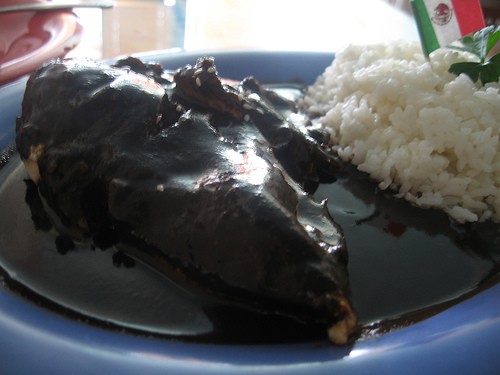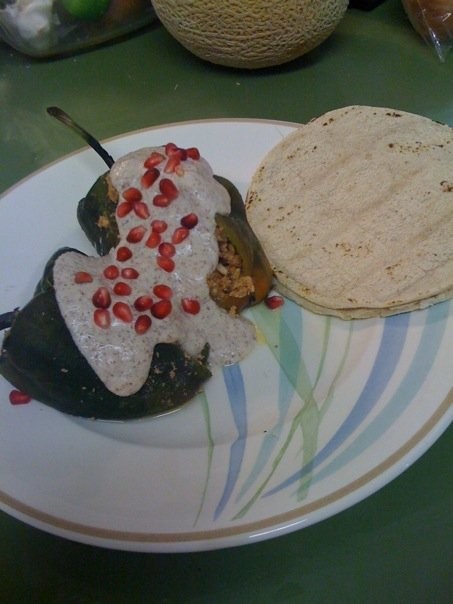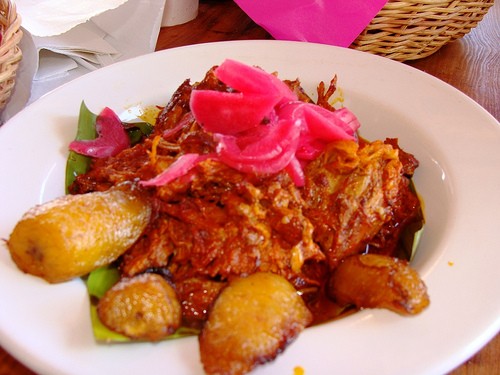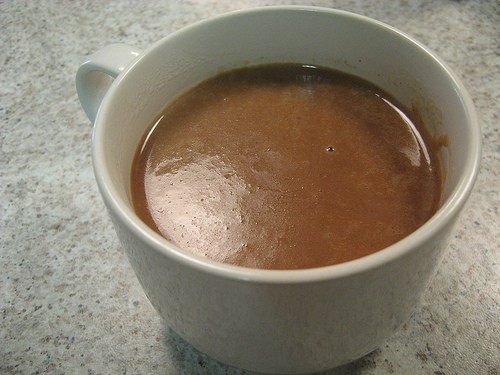Last week, I introduced you to (or re-acquainted you with) five foods recognizable to Mexicans living in México that ought to be more popular on this side of the border. Sandwiches, soup, barbecue, grilled fish and bacon.
México has a long, storied culinary history. This is the home of the Maya, of the Aztecs, of the Olmecs: there was a flourishing, mature civilization with a huge store of knowledge in southern México while my Nordic ancestors were still grubbing around for amber to trade. It shouldn't be a surprise, then, that it was easy to come up with five more of Mexico's finest foods.

]
6. Mole negro
A lot of people know mole as “that chocolate sauce”, but to try and
compose a list of the ingredients of mole negro would be impossible. It
contains six kinds of chiles and at least two dozen other ingredients,
from raisins to dried avocado leaves to, yes, unsweetened chocolate. It
takes all day (or multiple days) to prepare, but the end result is a
thick sauce that lays on its target food like no other in the world and
provides mindbending flavor that nothing else in the world can hope to
match.
Mole negro, when it is available in the U.S., tends to be served over
chicken, but its true home is on turkey (mole negro de guajolote), whose
slight gaminess completes the dish. Another mole dish that should be
more common is enmoladas, tortillas dipped in mole and then rolled
around ingredients such as chicken or turkey. It makes a great
Thanksgiving leftover, especially if you live near a Mexican market that
can hook you up with mole started base. It won't be the same as
made-from-scratch, but there are still some good ones out there.
7. Chiles en nogada

The chile relleno is one of the more common dishes in the
Mexican-American repertoire, but almost every Anglo in the U.S. knows it
as a poblano chile (that's the big green one that looks like a crumpled
bell pepper) that's been stuffed with cheese, battered in egg and
deep-fried. While these are an occasional guilty pleasure, they are
certainly not the be-all and end-all of stuffed chiles in México.
The best stuffed chile is actually one of the national dishes of México,
partly due to the fact that it is red, white and green, the colors of
the Mexican flag. The same poblano chile is stuffed with picadillo, a
slightly sweet concoction of ground meat, fruit (pears, peaches and
apples, commonly), warm spices like cinnamon and cloves, and a little
bit of chile for heat. It's then covered in a while sauce made from
milk, cream and peeled walnuts, and sprinkled with dark red pomegranate
seeds, which stand in for citrus while lending an acidic bite to the
dish.
Because the ingredients are in season only for a short while (September
and October in Southern California), this is an occasional dish–but a
very good one, and better for you than mountains of jack cheese.
8. Cochinita pibil

Cochinita means “piglet” in Spanish and pibil means
“buried” in Mayan, so it's probably not too hard to figure out what
cochinita pibil is, marinated suckling pig (or parts of a larger hog
such as the picnic ham) that has been roasted in banana leaves,
preferably in a pit.
Cochinita pibil's marinade always contains bitter (Seville) orange juice
and ground achiote (also called annatto seed), which lends a bright red
color to the marinade. The food is wrapped in banana leaves and roasted
slowly, either in an oven, a caja china, or in a true pit lined
with hot rocks. The end result is pork so tender it practically melts
upon contact with a fork, with a slight zing and a smoky flavor profile.
Cochinita pibil is usually served with tortillas, marinated red onions,
and the incendiary xnipec (“dog's nose” in Mayan) salsa, made with
tomatoes and habanero chiles.
9. Atole / Champurrado

Champurrado is a Mexican drink similar to a very, very thick hot
chocolate. It's made by toasting corn dough on a hot iron griddle and
then mixing with chocolate, piloncillo, and water that has had various
spices simmered in it. The result is almost thick enough to be called a
shake, but served hot.
If you leave the chocolate out, you have atole, the generic Spanish word
for this kind of drink. Different additions yield different drinks; you
may find anise-flavored atole, or strawberry, coconut, vanilla, or any
number of other kinds.
Atole goes with tamales (you do know what tamales are, yes?) the way
peanut butter goes with jelly.
10. Capirotada

Capirotada is to regular bread pudding as Valrhona chocolate mousse is
to Jell-O™ Instant Artificially Chocolate Flavored Pudding. Regular
bread pudding is simply a thin custard (eggs, milk or cream, sugar and
flavorings) poured over stale bread, allowed to soak in, and baked.
Capirotada is toasted bread with cheese, raisins, walnuts, and an entire
pantry's worth of spices, bathed in syrup made from piloncillo, the
cone-shaped unrefined sugar of México, then baked under the custard.
It's a traditional Lenten dish (that would be now) and tastes like bread
pudding with the flavor turned up.


CBD exceeded my expectations in every way thanks [url=https://www.cornbreadhemp.com/blogs/learn/cbd-gummies-dosage-guide ]https://www.cornbreadhemp.com/blogs/learn/cbd-gummies-dosage-guide [/url]. I’ve struggled with insomnia looking for years, and after infuriating CBD in the course of the first mores, I lastly practised a full eventide of pacific sleep. It was like a weight had been lifted off my shoulders. The calming effects were merciful after all scholarly, allowing me to drift off naturally without sensibilities punchy the next morning. I also noticed a reduction in my daytime apprehension, which was an unexpected but welcome bonus. The cultivation was a bit shameless, but nothing intolerable. Blanket, CBD has been a game-changer quest of my slumber and anxiety issues, and I’m appreciative to procure discovered its benefits.